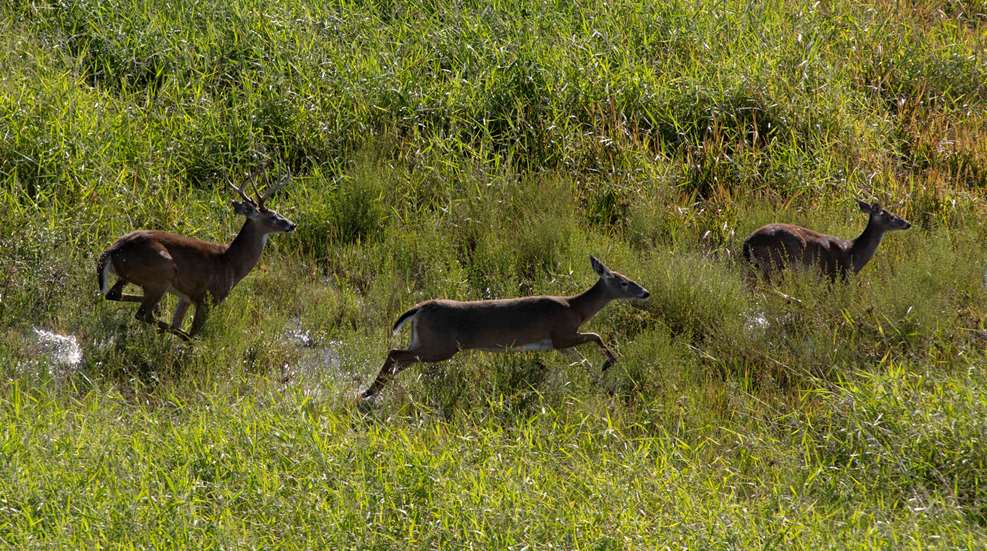
Hunting magazines talk about the rut like it’s the end-all, be-all of deer hunting—and not for no reason. Whitetail bucks do kind of lose their minds during the rut (peak breeding time) and are much more likely to make a mistake that puts them in front of your treestand during daylight hours.
But in many states, firearms season doesn’t overlap with the rut, which makes hunting this magical week or two with a rifle out of the question. The rut varies a little depending on what part of the country you’re in, but in most places, it peaks around the first or second week of November, give or take a few days. After that, deer enter what some call a “lockdown” period for a week or two, and what we call the “post rut” starts the last week of November and runs into the first half of December. Hunting this period is a little more challenging than hunting during the frenzy of the rut, but you can still find success with these tips.
Mind the Travel Patterns
Deer will be mostly heading back to the bedding/feeding/traveling patterns they were in prior to the rut. While this makes them more nocturnal again, they’ll also be a little more predictable, which you can use to your advantage. Hunting the travel routes they’re using to move from bedding areas to feeding areas, particularly focusing on funnels if you can find them. A funnel, much like it sounds, some kind of natural pinch point that lots of deer will be passing through.
Focus on Food
Bucks have run themselves ragged during the rut, losing up to 25 percent of their body weight. They’re tired and hungry, and they’ve got to build their bulk back up to survive the rest of winter—so you’ll find them on food plots and seeking out food sources like acorns, agricultural fields and more. The closer the food source is to reliable cover, the better, so try hunting the edges of food plots or fields. Deer might be bedding closer to food than usual in an attempt to conserve energy moving back and forth, so be cautious when walking in—you don’t want to go stomping through bedding areas and spooking deer.
Try Still-Hunting
Bucks will be moving a lot less than they were just a week or two ago—they’re tired and they’ve probably been pressured by other hunters in the woods, making them wary—so you might have to go find them instead of waiting for them to come to you. If you’re not having luck setting up on travel routes or feeding areas, you might have to get out of the stand and move around a little. Be careful where you do this, especially on public land, but it can be very effective.
Still-hunting is best described as an extremely slow walk in the woods with long pauses between steps. You won’t cover a ton of ground, unless maybe you happen upon fresh tracks and decide to follow them. It’s a lot of watching and waiting, listening and scanning, looking for the slightest movement and trying to glimpse the flick of an ear or the flash of an antler. Again, don’t go stomping into bedding areas unless you’re cool with ruining that section for the rest of the season.
How About a Drive?
When the bucks aren’t moving, a deer drive can make them move. You don’t need a ton of people for this—two or three is the minimum, but more is better (to a point). What a drive does need is coordination and strict rules.
You’ll have sitters and drivers. The sitters will position themselves at one end of a field or a section of woods, far enough apart that they each have their own safe shooting zones. The drivers will walk through the field or woods starting at the opposite end, with the idea being that they will spook deer who are bedded down and push them toward the waiting shooters. Shooters need to know what directions they’re safe to shoot in, and drivers need to know where shooters and the other drivers are going to be so they can take a safe shot if it presents itself (if this is impossible to coordinate, make a rule that drivers don’t shoot). And, obviously, everyone wears blaze orange for safety.
Don’t Forget the Second Rut
About a month after the rut, the does that didn’t get bred can go through another estrus cycle, and the young female fawns that didn’t go through estrus at all are now a month older and may be starting their first-ever cycle. Some hunters say this is just a continuation of the first rut, while some call it a whole separate event. It is more prevalent in some areas than others, but no matter what you believe about it, the fact remains that some spots do see a spike in deer activity about a month after the peak of the rut.
If you’re seeing rut-like activity again in early to mid December—bucks chasing does, more daytime photos on your trail cameras, fresh rubs and scrapes—get out there and hunt if you can. Calling can be particularly effective during the second rut, because the estrous does are fewer and farther between than they were a month ago, which means the bucks must work harder to find them, and they might be more eager to respond to a grunt call or a bleat call in desperation.














































